Performance Management and Team Rewards: Brick Co. Case Study, 2020
VerifiedAdded on 2023/01/12
|9
|2663
|100
Case Study
AI Summary
This case study examines the performance management system implemented at Brick Co., a company aiming to align employee performance with organizational goals. The report delves into the role of performance management systems, emphasizing their importance in measuring employee performance, aligning business objectives, and facilitating continuous improvement. It highlights the significance of team and team-based reward systems in fostering collaboration, enhancing employee motivation, and boosting overall organizational performance. Furthermore, the case study explores the connection between performance management and employee engagement and commitment, outlining strategies to enhance these aspects. Challenges in implementing such systems are also acknowledged. The analysis covers various aspects, from aligning goals and facilitating employee development to encouraging open communication and providing feedback, ultimately aiming to improve productivity and retention within the organization. The case study concludes by providing insights into the practical application of performance management tools and strategies for achieving optimal results in a competitive business environment.
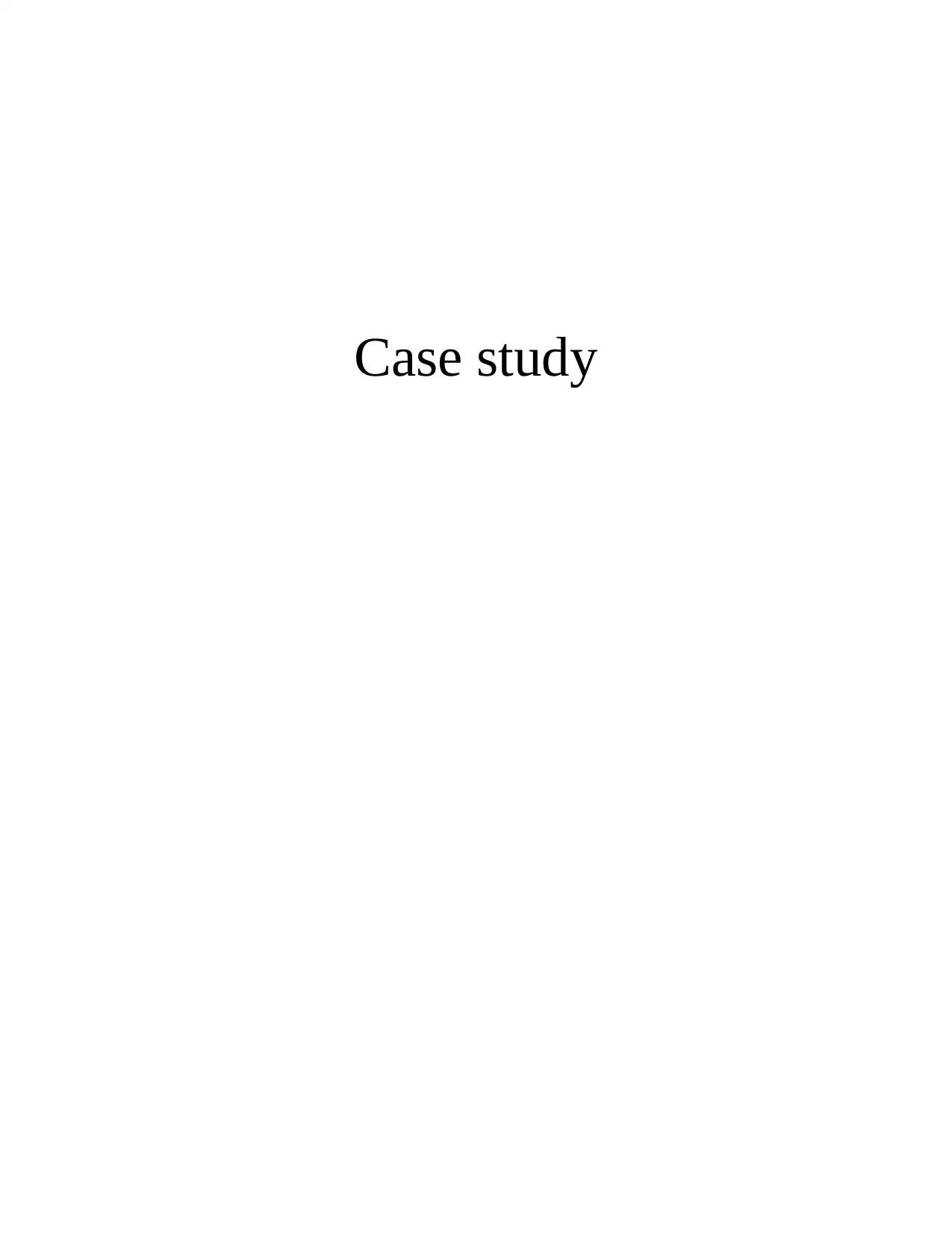
Case study
Paraphrase This Document
Need a fresh take? Get an instant paraphrase of this document with our AI Paraphraser
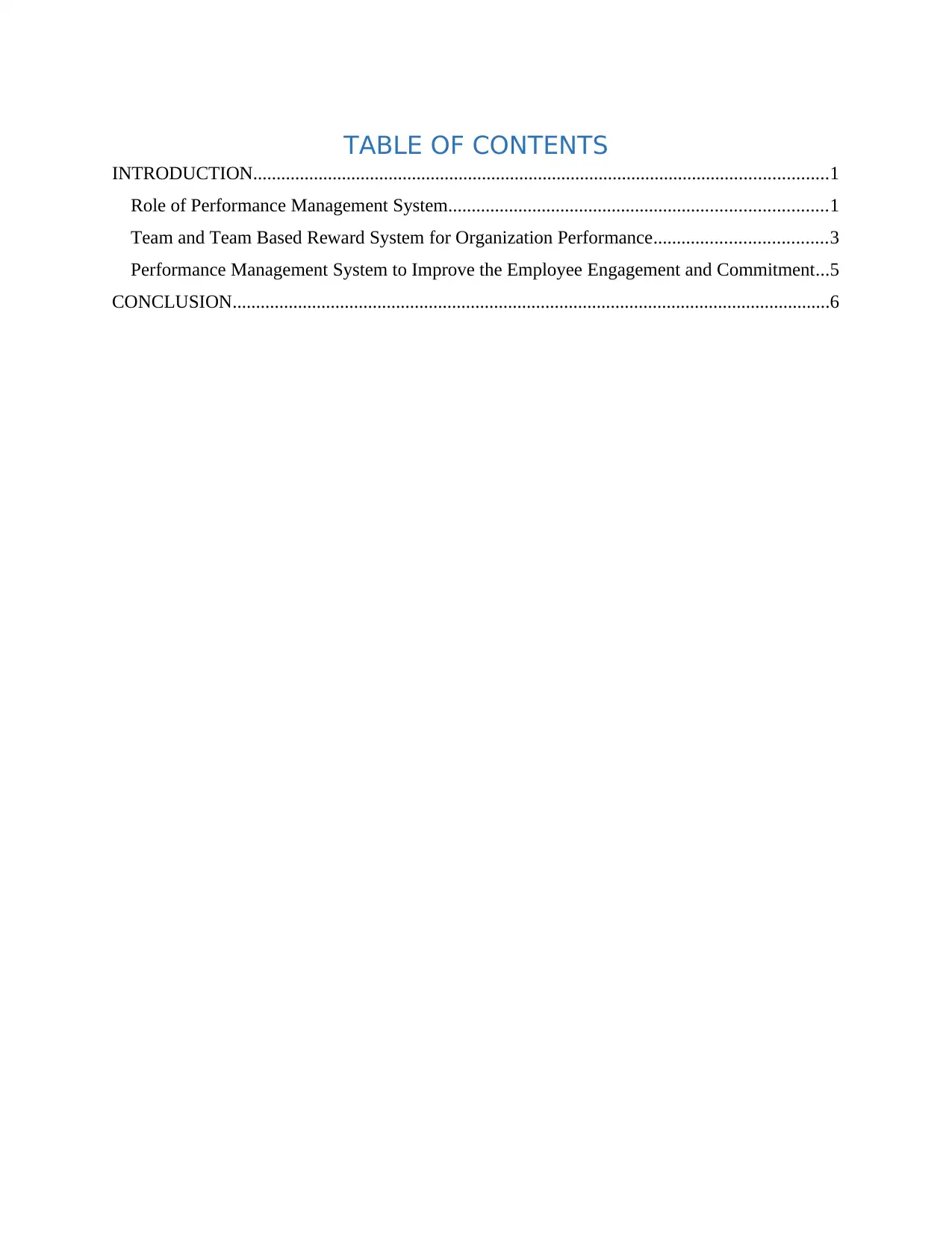
TABLE OF CONTENTS
INTRODUCTION...........................................................................................................................1
Role of Performance Management System.................................................................................1
Team and Team Based Reward System for Organization Performance.....................................3
Performance Management System to Improve the Employee Engagement and Commitment...5
CONCLUSION................................................................................................................................6
INTRODUCTION...........................................................................................................................1
Role of Performance Management System.................................................................................1
Team and Team Based Reward System for Organization Performance.....................................3
Performance Management System to Improve the Employee Engagement and Commitment...5
CONCLUSION................................................................................................................................6
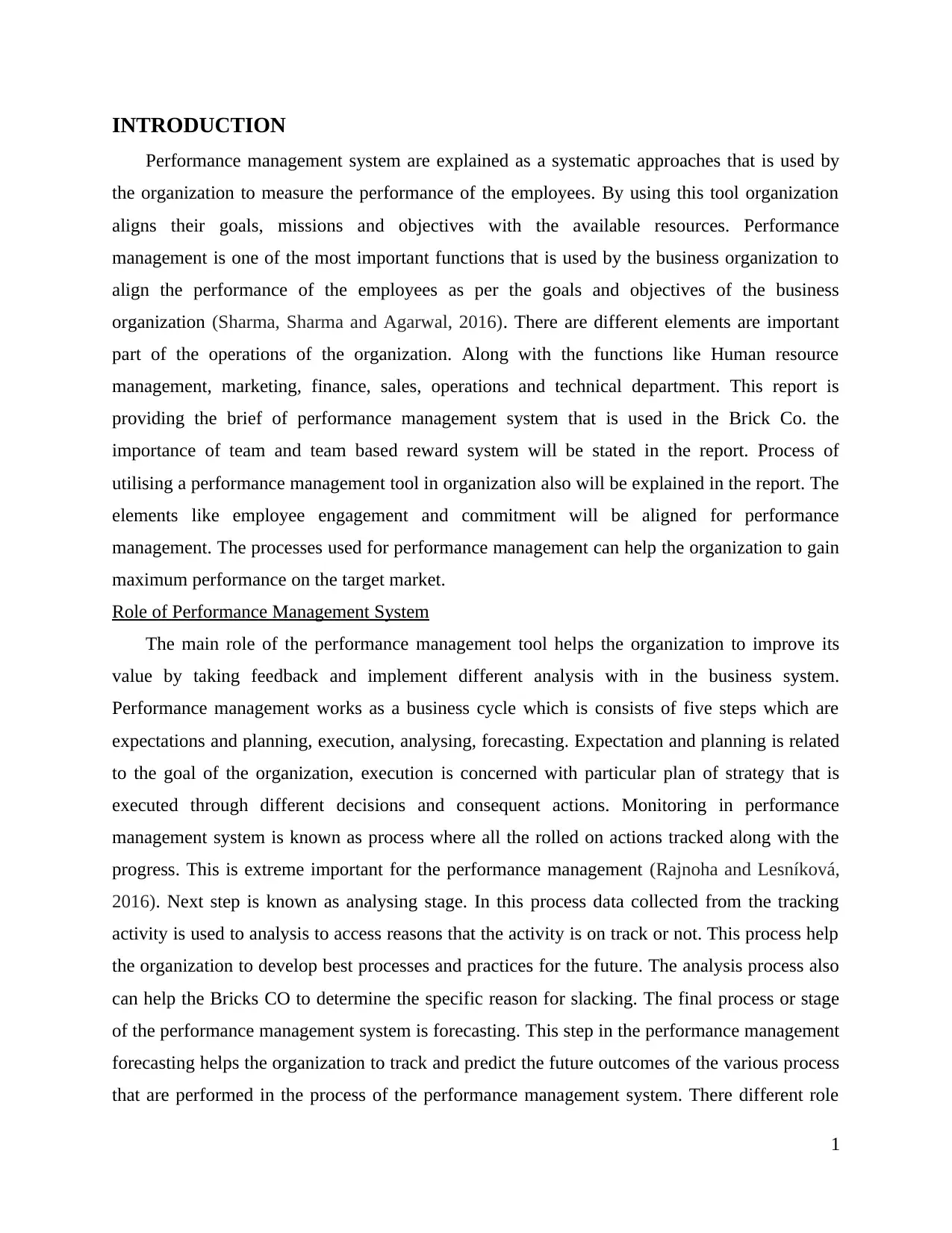
INTRODUCTION
Performance management system are explained as a systematic approaches that is used by
the organization to measure the performance of the employees. By using this tool organization
aligns their goals, missions and objectives with the available resources. Performance
management is one of the most important functions that is used by the business organization to
align the performance of the employees as per the goals and objectives of the business
organization (Sharma, Sharma and Agarwal, 2016). There are different elements are important
part of the operations of the organization. Along with the functions like Human resource
management, marketing, finance, sales, operations and technical department. This report is
providing the brief of performance management system that is used in the Brick Co. the
importance of team and team based reward system will be stated in the report. Process of
utilising a performance management tool in organization also will be explained in the report. The
elements like employee engagement and commitment will be aligned for performance
management. The processes used for performance management can help the organization to gain
maximum performance on the target market.
Role of Performance Management System
The main role of the performance management tool helps the organization to improve its
value by taking feedback and implement different analysis with in the business system.
Performance management works as a business cycle which is consists of five steps which are
expectations and planning, execution, analysing, forecasting. Expectation and planning is related
to the goal of the organization, execution is concerned with particular plan of strategy that is
executed through different decisions and consequent actions. Monitoring in performance
management system is known as process where all the rolled on actions tracked along with the
progress. This is extreme important for the performance management (Rajnoha and Lesníková,
2016). Next step is known as analysing stage. In this process data collected from the tracking
activity is used to analysis to access reasons that the activity is on track or not. This process help
the organization to develop best processes and practices for the future. The analysis process also
can help the Bricks CO to determine the specific reason for slacking. The final process or stage
of the performance management system is forecasting. This step in the performance management
forecasting helps the organization to track and predict the future outcomes of the various process
that are performed in the process of the performance management system. There different role
1
Performance management system are explained as a systematic approaches that is used by
the organization to measure the performance of the employees. By using this tool organization
aligns their goals, missions and objectives with the available resources. Performance
management is one of the most important functions that is used by the business organization to
align the performance of the employees as per the goals and objectives of the business
organization (Sharma, Sharma and Agarwal, 2016). There are different elements are important
part of the operations of the organization. Along with the functions like Human resource
management, marketing, finance, sales, operations and technical department. This report is
providing the brief of performance management system that is used in the Brick Co. the
importance of team and team based reward system will be stated in the report. Process of
utilising a performance management tool in organization also will be explained in the report. The
elements like employee engagement and commitment will be aligned for performance
management. The processes used for performance management can help the organization to gain
maximum performance on the target market.
Role of Performance Management System
The main role of the performance management tool helps the organization to improve its
value by taking feedback and implement different analysis with in the business system.
Performance management works as a business cycle which is consists of five steps which are
expectations and planning, execution, analysing, forecasting. Expectation and planning is related
to the goal of the organization, execution is concerned with particular plan of strategy that is
executed through different decisions and consequent actions. Monitoring in performance
management system is known as process where all the rolled on actions tracked along with the
progress. This is extreme important for the performance management (Rajnoha and Lesníková,
2016). Next step is known as analysing stage. In this process data collected from the tracking
activity is used to analysis to access reasons that the activity is on track or not. This process help
the organization to develop best processes and practices for the future. The analysis process also
can help the Bricks CO to determine the specific reason for slacking. The final process or stage
of the performance management system is forecasting. This step in the performance management
forecasting helps the organization to track and predict the future outcomes of the various process
that are performed in the process of the performance management system. There different role
1
⊘ This is a preview!⊘
Do you want full access?
Subscribe today to unlock all pages.

Trusted by 1+ million students worldwide
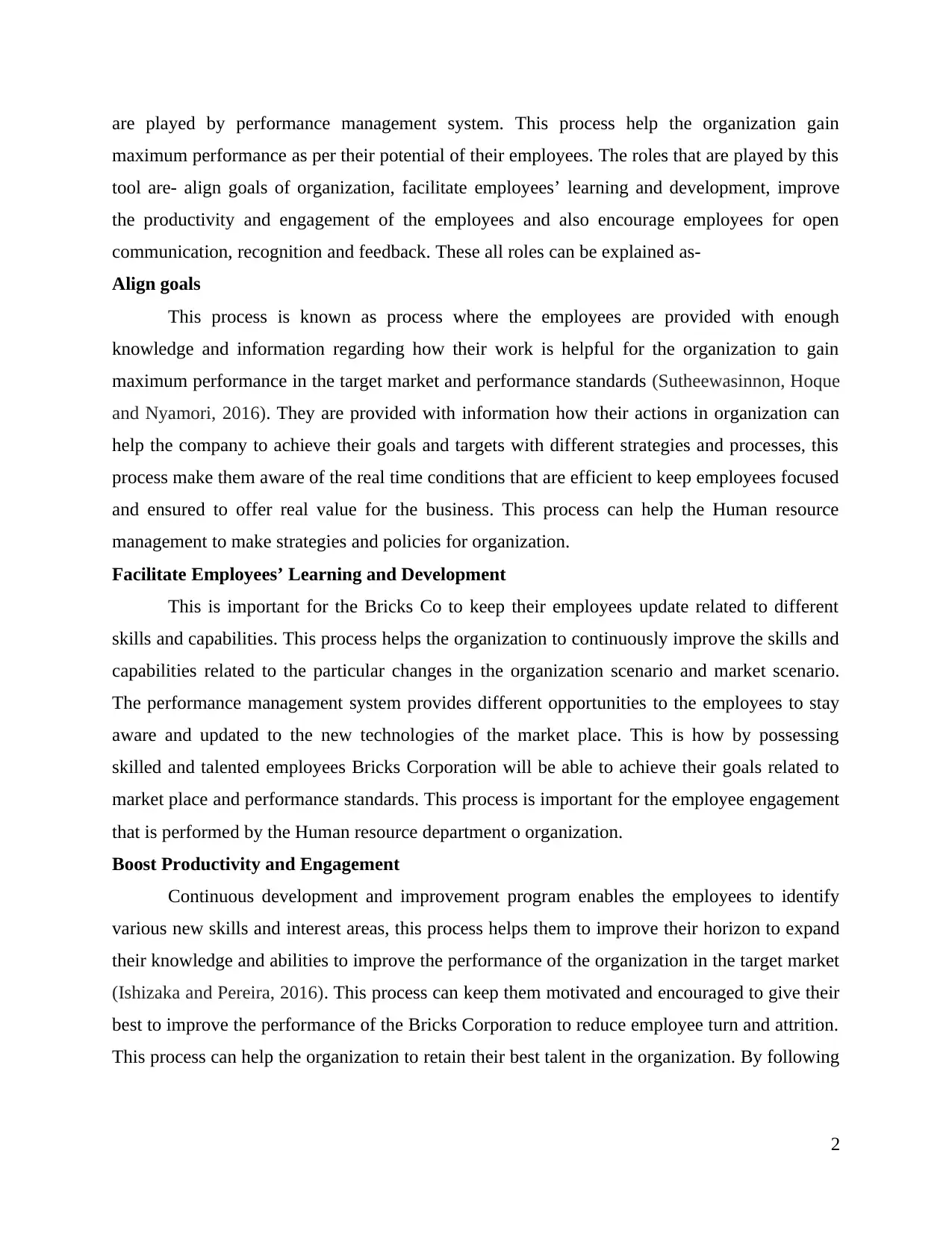
are played by performance management system. This process help the organization gain
maximum performance as per their potential of their employees. The roles that are played by this
tool are- align goals of organization, facilitate employees’ learning and development, improve
the productivity and engagement of the employees and also encourage employees for open
communication, recognition and feedback. These all roles can be explained as-
Align goals
This process is known as process where the employees are provided with enough
knowledge and information regarding how their work is helpful for the organization to gain
maximum performance in the target market and performance standards (Sutheewasinnon, Hoque
and Nyamori, 2016). They are provided with information how their actions in organization can
help the company to achieve their goals and targets with different strategies and processes, this
process make them aware of the real time conditions that are efficient to keep employees focused
and ensured to offer real value for the business. This process can help the Human resource
management to make strategies and policies for organization.
Facilitate Employees’ Learning and Development
This is important for the Bricks Co to keep their employees update related to different
skills and capabilities. This process helps the organization to continuously improve the skills and
capabilities related to the particular changes in the organization scenario and market scenario.
The performance management system provides different opportunities to the employees to stay
aware and updated to the new technologies of the market place. This is how by possessing
skilled and talented employees Bricks Corporation will be able to achieve their goals related to
market place and performance standards. This process is important for the employee engagement
that is performed by the Human resource department o organization.
Boost Productivity and Engagement
Continuous development and improvement program enables the employees to identify
various new skills and interest areas, this process helps them to improve their horizon to expand
their knowledge and abilities to improve the performance of the organization in the target market
(Ishizaka and Pereira, 2016). This process can keep them motivated and encouraged to give their
best to improve the performance of the Bricks Corporation to reduce employee turn and attrition.
This process can help the organization to retain their best talent in the organization. By following
2
maximum performance as per their potential of their employees. The roles that are played by this
tool are- align goals of organization, facilitate employees’ learning and development, improve
the productivity and engagement of the employees and also encourage employees for open
communication, recognition and feedback. These all roles can be explained as-
Align goals
This process is known as process where the employees are provided with enough
knowledge and information regarding how their work is helpful for the organization to gain
maximum performance in the target market and performance standards (Sutheewasinnon, Hoque
and Nyamori, 2016). They are provided with information how their actions in organization can
help the company to achieve their goals and targets with different strategies and processes, this
process make them aware of the real time conditions that are efficient to keep employees focused
and ensured to offer real value for the business. This process can help the Human resource
management to make strategies and policies for organization.
Facilitate Employees’ Learning and Development
This is important for the Bricks Co to keep their employees update related to different
skills and capabilities. This process helps the organization to continuously improve the skills and
capabilities related to the particular changes in the organization scenario and market scenario.
The performance management system provides different opportunities to the employees to stay
aware and updated to the new technologies of the market place. This is how by possessing
skilled and talented employees Bricks Corporation will be able to achieve their goals related to
market place and performance standards. This process is important for the employee engagement
that is performed by the Human resource department o organization.
Boost Productivity and Engagement
Continuous development and improvement program enables the employees to identify
various new skills and interest areas, this process helps them to improve their horizon to expand
their knowledge and abilities to improve the performance of the organization in the target market
(Ishizaka and Pereira, 2016). This process can keep them motivated and encouraged to give their
best to improve the performance of the Bricks Corporation to reduce employee turn and attrition.
This process can help the organization to retain their best talent in the organization. By following
2
Paraphrase This Document
Need a fresh take? Get an instant paraphrase of this document with our AI Paraphraser
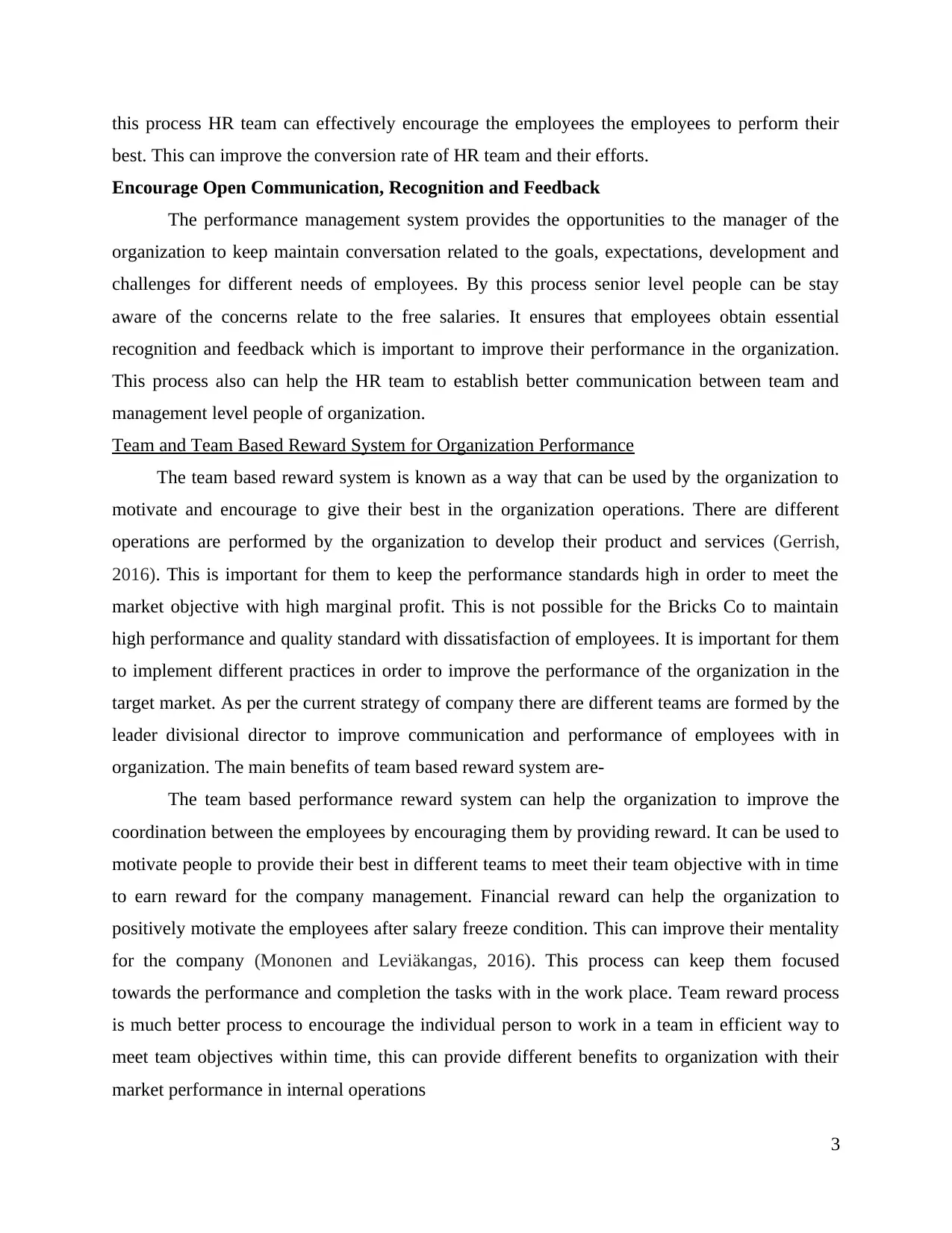
this process HR team can effectively encourage the employees the employees to perform their
best. This can improve the conversion rate of HR team and their efforts.
Encourage Open Communication, Recognition and Feedback
The performance management system provides the opportunities to the manager of the
organization to keep maintain conversation related to the goals, expectations, development and
challenges for different needs of employees. By this process senior level people can be stay
aware of the concerns relate to the free salaries. It ensures that employees obtain essential
recognition and feedback which is important to improve their performance in the organization.
This process also can help the HR team to establish better communication between team and
management level people of organization.
Team and Team Based Reward System for Organization Performance
The team based reward system is known as a way that can be used by the organization to
motivate and encourage to give their best in the organization operations. There are different
operations are performed by the organization to develop their product and services (Gerrish,
2016). This is important for them to keep the performance standards high in order to meet the
market objective with high marginal profit. This is not possible for the Bricks Co to maintain
high performance and quality standard with dissatisfaction of employees. It is important for them
to implement different practices in order to improve the performance of the organization in the
target market. As per the current strategy of company there are different teams are formed by the
leader divisional director to improve communication and performance of employees with in
organization. The main benefits of team based reward system are-
The team based performance reward system can help the organization to improve the
coordination between the employees by encouraging them by providing reward. It can be used to
motivate people to provide their best in different teams to meet their team objective with in time
to earn reward for the company management. Financial reward can help the organization to
positively motivate the employees after salary freeze condition. This can improve their mentality
for the company (Mononen and Leviäkangas, 2016). This process can keep them focused
towards the performance and completion the tasks with in the work place. Team reward process
is much better process to encourage the individual person to work in a team in efficient way to
meet team objectives within time, this can provide different benefits to organization with their
market performance in internal operations
3
best. This can improve the conversion rate of HR team and their efforts.
Encourage Open Communication, Recognition and Feedback
The performance management system provides the opportunities to the manager of the
organization to keep maintain conversation related to the goals, expectations, development and
challenges for different needs of employees. By this process senior level people can be stay
aware of the concerns relate to the free salaries. It ensures that employees obtain essential
recognition and feedback which is important to improve their performance in the organization.
This process also can help the HR team to establish better communication between team and
management level people of organization.
Team and Team Based Reward System for Organization Performance
The team based reward system is known as a way that can be used by the organization to
motivate and encourage to give their best in the organization operations. There are different
operations are performed by the organization to develop their product and services (Gerrish,
2016). This is important for them to keep the performance standards high in order to meet the
market objective with high marginal profit. This is not possible for the Bricks Co to maintain
high performance and quality standard with dissatisfaction of employees. It is important for them
to implement different practices in order to improve the performance of the organization in the
target market. As per the current strategy of company there are different teams are formed by the
leader divisional director to improve communication and performance of employees with in
organization. The main benefits of team based reward system are-
The team based performance reward system can help the organization to improve the
coordination between the employees by encouraging them by providing reward. It can be used to
motivate people to provide their best in different teams to meet their team objective with in time
to earn reward for the company management. Financial reward can help the organization to
positively motivate the employees after salary freeze condition. This can improve their mentality
for the company (Mononen and Leviäkangas, 2016). This process can keep them focused
towards the performance and completion the tasks with in the work place. Team reward process
is much better process to encourage the individual person to work in a team in efficient way to
meet team objectives within time, this can provide different benefits to organization with their
market performance in internal operations
3

The other benefits of this team based performance is regarding common goals of
organization. Each team have specific goals that are based on the common goal of organization
this is important for the organization to provide tasks to different team to meet main objective of
the team effectively. When the organization is facing different issues with their performance in
the target market them this team based reward system can encourage them to work unitedly to
achieve company with cost and time efficiency. Effective team working can help the
organization to create better strategy to full fill main objective company (Kokina, Pachamanova
and Corbett, 2017). Effective team working can encourage people with in the teams to encourage
each other to avoid negative mentality in the team and get encouraged in order to give their best
in the organization performance. This process also can encourage the people to work much
harder and smartly in order to complete the complete market objective with high efficiency.
The main benefit of the team based reward system is about the collaborative actions of
the employees to meet the company objectives with maximum possible efficiency. The result of
team is much better than the individual performance for organization. This collaborate team
working is able to meet the company objectives with high efficiency, time and cost effectiveness
to the company. In teams different type of people are there, who have different thinking process
and different mind set in team. Team and team based reward can motivate them to equally
participate in the team performance to provide their contribution in the success of the team. This
team and team based reward system can motivate the team members to get committed to the
team plan for the best execution of the team and organization strategy. For the complex task this
is difficult to work individually. Team based reward system can encourages to the team members
to put their efforts unitedly to complete complex tasks with high efficiency. By this process of
team and team based reward organization to make these complex tasks as opportunity for them
to get reward by completing thee tasks with high efficiency (Kim and Kang, 2016). This is more
effective to keep these team much smaller in order to develop positive outcome from this process
of team operation. This also can help the organization to track the performance of the each
employee to evaluate their performance for the organization. Small team are highly responding
to the team based reward process. Process of providing effectively work on these small teams to
give their best in the overall performance of the organization.
4
organization. Each team have specific goals that are based on the common goal of organization
this is important for the organization to provide tasks to different team to meet main objective of
the team effectively. When the organization is facing different issues with their performance in
the target market them this team based reward system can encourage them to work unitedly to
achieve company with cost and time efficiency. Effective team working can help the
organization to create better strategy to full fill main objective company (Kokina, Pachamanova
and Corbett, 2017). Effective team working can encourage people with in the teams to encourage
each other to avoid negative mentality in the team and get encouraged in order to give their best
in the organization performance. This process also can encourage the people to work much
harder and smartly in order to complete the complete market objective with high efficiency.
The main benefit of the team based reward system is about the collaborative actions of
the employees to meet the company objectives with maximum possible efficiency. The result of
team is much better than the individual performance for organization. This collaborate team
working is able to meet the company objectives with high efficiency, time and cost effectiveness
to the company. In teams different type of people are there, who have different thinking process
and different mind set in team. Team and team based reward can motivate them to equally
participate in the team performance to provide their contribution in the success of the team. This
team and team based reward system can motivate the team members to get committed to the
team plan for the best execution of the team and organization strategy. For the complex task this
is difficult to work individually. Team based reward system can encourages to the team members
to put their efforts unitedly to complete complex tasks with high efficiency. By this process of
team and team based reward organization to make these complex tasks as opportunity for them
to get reward by completing thee tasks with high efficiency (Kim and Kang, 2016). This is more
effective to keep these team much smaller in order to develop positive outcome from this process
of team operation. This also can help the organization to track the performance of the each
employee to evaluate their performance for the organization. Small team are highly responding
to the team based reward process. Process of providing effectively work on these small teams to
give their best in the overall performance of the organization.
4
⊘ This is a preview!⊘
Do you want full access?
Subscribe today to unlock all pages.

Trusted by 1+ million students worldwide
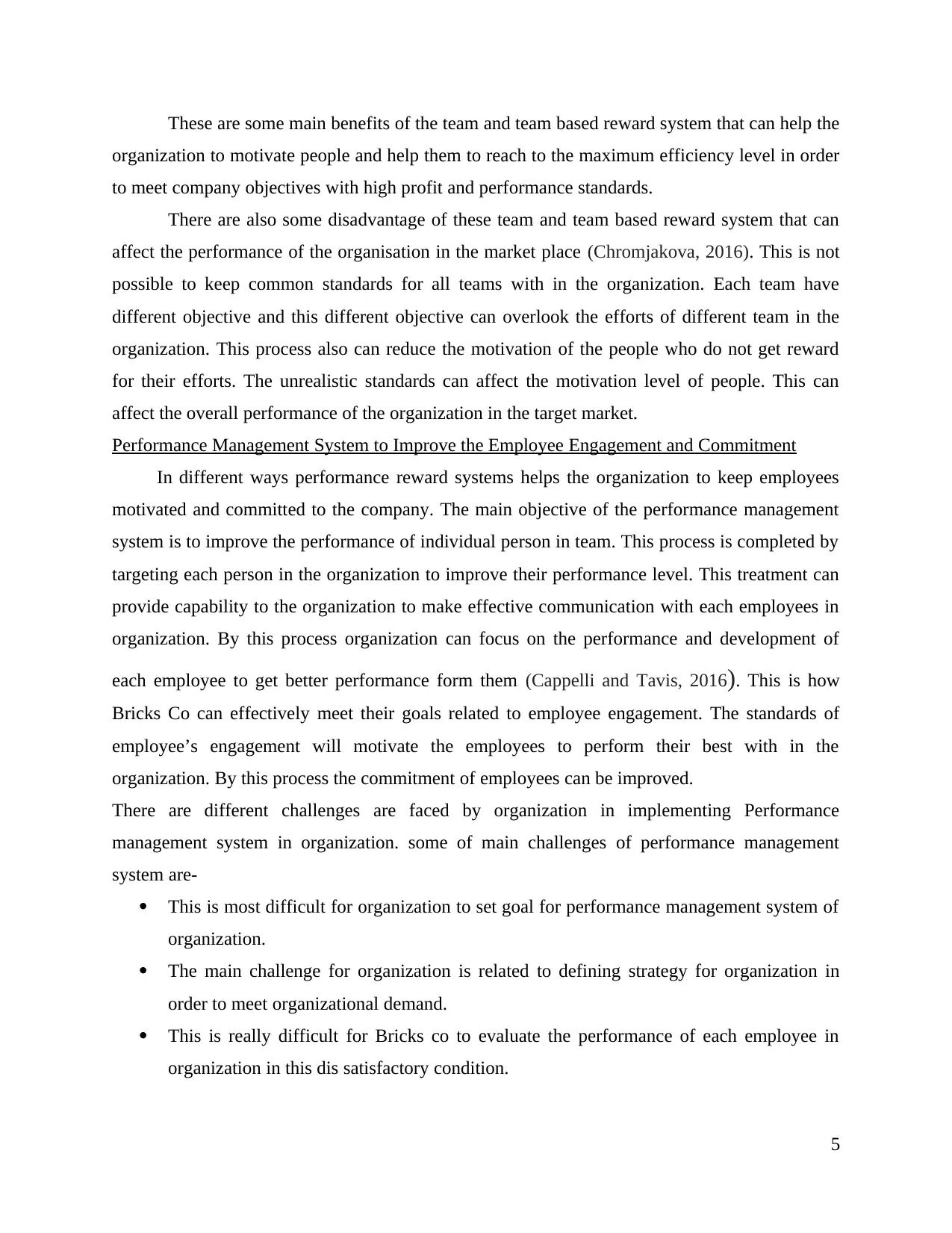
These are some main benefits of the team and team based reward system that can help the
organization to motivate people and help them to reach to the maximum efficiency level in order
to meet company objectives with high profit and performance standards.
There are also some disadvantage of these team and team based reward system that can
affect the performance of the organisation in the market place (Chromjakova, 2016). This is not
possible to keep common standards for all teams with in the organization. Each team have
different objective and this different objective can overlook the efforts of different team in the
organization. This process also can reduce the motivation of the people who do not get reward
for their efforts. The unrealistic standards can affect the motivation level of people. This can
affect the overall performance of the organization in the target market.
Performance Management System to Improve the Employee Engagement and Commitment
In different ways performance reward systems helps the organization to keep employees
motivated and committed to the company. The main objective of the performance management
system is to improve the performance of individual person in team. This process is completed by
targeting each person in the organization to improve their performance level. This treatment can
provide capability to the organization to make effective communication with each employees in
organization. By this process organization can focus on the performance and development of
each employee to get better performance form them (Cappelli and Tavis, 2016). This is how
Bricks Co can effectively meet their goals related to employee engagement. The standards of
employee’s engagement will motivate the employees to perform their best with in the
organization. By this process the commitment of employees can be improved.
There are different challenges are faced by organization in implementing Performance
management system in organization. some of main challenges of performance management
system are-
This is most difficult for organization to set goal for performance management system of
organization.
The main challenge for organization is related to defining strategy for organization in
order to meet organizational demand.
This is really difficult for Bricks co to evaluate the performance of each employee in
organization in this dis satisfactory condition.
5
organization to motivate people and help them to reach to the maximum efficiency level in order
to meet company objectives with high profit and performance standards.
There are also some disadvantage of these team and team based reward system that can
affect the performance of the organisation in the market place (Chromjakova, 2016). This is not
possible to keep common standards for all teams with in the organization. Each team have
different objective and this different objective can overlook the efforts of different team in the
organization. This process also can reduce the motivation of the people who do not get reward
for their efforts. The unrealistic standards can affect the motivation level of people. This can
affect the overall performance of the organization in the target market.
Performance Management System to Improve the Employee Engagement and Commitment
In different ways performance reward systems helps the organization to keep employees
motivated and committed to the company. The main objective of the performance management
system is to improve the performance of individual person in team. This process is completed by
targeting each person in the organization to improve their performance level. This treatment can
provide capability to the organization to make effective communication with each employees in
organization. By this process organization can focus on the performance and development of
each employee to get better performance form them (Cappelli and Tavis, 2016). This is how
Bricks Co can effectively meet their goals related to employee engagement. The standards of
employee’s engagement will motivate the employees to perform their best with in the
organization. By this process the commitment of employees can be improved.
There are different challenges are faced by organization in implementing Performance
management system in organization. some of main challenges of performance management
system are-
This is most difficult for organization to set goal for performance management system of
organization.
The main challenge for organization is related to defining strategy for organization in
order to meet organizational demand.
This is really difficult for Bricks co to evaluate the performance of each employee in
organization in this dis satisfactory condition.
5
Paraphrase This Document
Need a fresh take? Get an instant paraphrase of this document with our AI Paraphraser
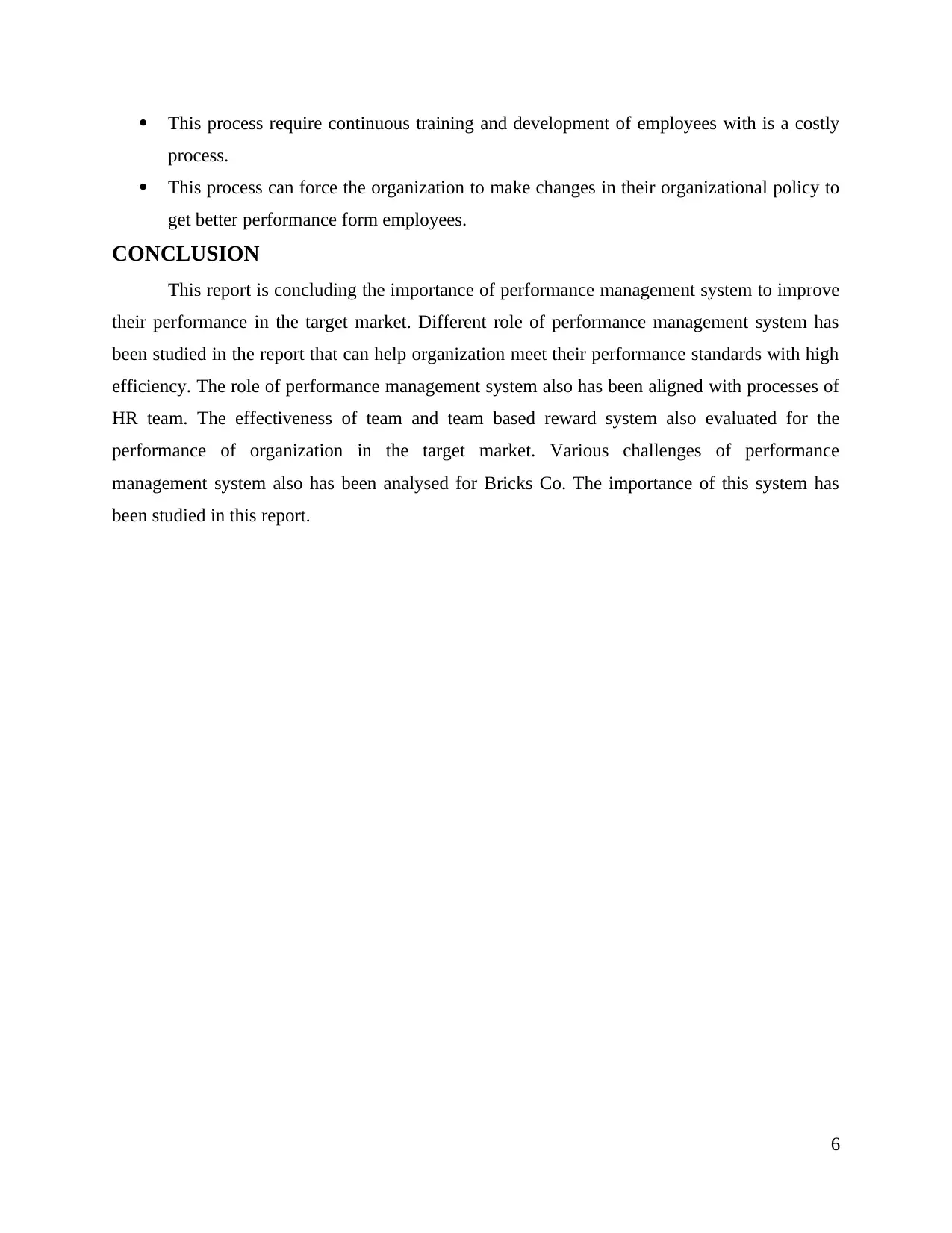
This process require continuous training and development of employees with is a costly
process.
This process can force the organization to make changes in their organizational policy to
get better performance form employees.
CONCLUSION
This report is concluding the importance of performance management system to improve
their performance in the target market. Different role of performance management system has
been studied in the report that can help organization meet their performance standards with high
efficiency. The role of performance management system also has been aligned with processes of
HR team. The effectiveness of team and team based reward system also evaluated for the
performance of organization in the target market. Various challenges of performance
management system also has been analysed for Bricks Co. The importance of this system has
been studied in this report.
6
process.
This process can force the organization to make changes in their organizational policy to
get better performance form employees.
CONCLUSION
This report is concluding the importance of performance management system to improve
their performance in the target market. Different role of performance management system has
been studied in the report that can help organization meet their performance standards with high
efficiency. The role of performance management system also has been aligned with processes of
HR team. The effectiveness of team and team based reward system also evaluated for the
performance of organization in the target market. Various challenges of performance
management system also has been analysed for Bricks Co. The importance of this system has
been studied in this report.
6
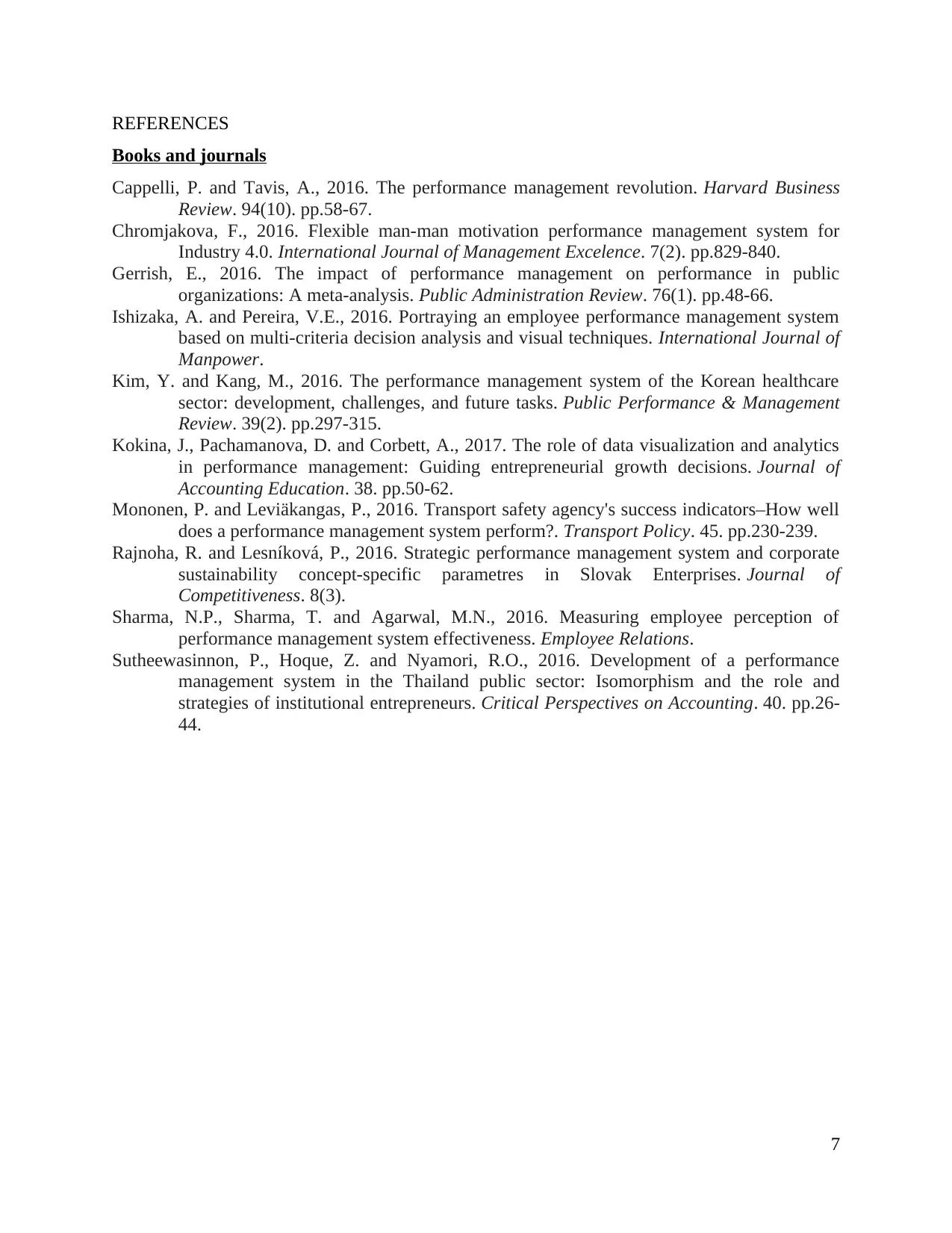
REFERENCES
Books and journals
Cappelli, P. and Tavis, A., 2016. The performance management revolution. Harvard Business
Review. 94(10). pp.58-67.
Chromjakova, F., 2016. Flexible man-man motivation performance management system for
Industry 4.0. International Journal of Management Excelence. 7(2). pp.829-840.
Gerrish, E., 2016. The impact of performance management on performance in public
organizations: A meta‐analysis. Public Administration Review. 76(1). pp.48-66.
Ishizaka, A. and Pereira, V.E., 2016. Portraying an employee performance management system
based on multi-criteria decision analysis and visual techniques. International Journal of
Manpower.
Kim, Y. and Kang, M., 2016. The performance management system of the Korean healthcare
sector: development, challenges, and future tasks. Public Performance & Management
Review. 39(2). pp.297-315.
Kokina, J., Pachamanova, D. and Corbett, A., 2017. The role of data visualization and analytics
in performance management: Guiding entrepreneurial growth decisions. Journal of
Accounting Education. 38. pp.50-62.
Mononen, P. and Leviäkangas, P., 2016. Transport safety agency's success indicators–How well
does a performance management system perform?. Transport Policy. 45. pp.230-239.
Rajnoha, R. and Lesníková, P., 2016. Strategic performance management system and corporate
sustainability concept-specific parametres in Slovak Enterprises. Journal of
Competitiveness. 8(3).
Sharma, N.P., Sharma, T. and Agarwal, M.N., 2016. Measuring employee perception of
performance management system effectiveness. Employee Relations.
Sutheewasinnon, P., Hoque, Z. and Nyamori, R.O., 2016. Development of a performance
management system in the Thailand public sector: Isomorphism and the role and
strategies of institutional entrepreneurs. Critical Perspectives on Accounting. 40. pp.26-
44.
7
Books and journals
Cappelli, P. and Tavis, A., 2016. The performance management revolution. Harvard Business
Review. 94(10). pp.58-67.
Chromjakova, F., 2016. Flexible man-man motivation performance management system for
Industry 4.0. International Journal of Management Excelence. 7(2). pp.829-840.
Gerrish, E., 2016. The impact of performance management on performance in public
organizations: A meta‐analysis. Public Administration Review. 76(1). pp.48-66.
Ishizaka, A. and Pereira, V.E., 2016. Portraying an employee performance management system
based on multi-criteria decision analysis and visual techniques. International Journal of
Manpower.
Kim, Y. and Kang, M., 2016. The performance management system of the Korean healthcare
sector: development, challenges, and future tasks. Public Performance & Management
Review. 39(2). pp.297-315.
Kokina, J., Pachamanova, D. and Corbett, A., 2017. The role of data visualization and analytics
in performance management: Guiding entrepreneurial growth decisions. Journal of
Accounting Education. 38. pp.50-62.
Mononen, P. and Leviäkangas, P., 2016. Transport safety agency's success indicators–How well
does a performance management system perform?. Transport Policy. 45. pp.230-239.
Rajnoha, R. and Lesníková, P., 2016. Strategic performance management system and corporate
sustainability concept-specific parametres in Slovak Enterprises. Journal of
Competitiveness. 8(3).
Sharma, N.P., Sharma, T. and Agarwal, M.N., 2016. Measuring employee perception of
performance management system effectiveness. Employee Relations.
Sutheewasinnon, P., Hoque, Z. and Nyamori, R.O., 2016. Development of a performance
management system in the Thailand public sector: Isomorphism and the role and
strategies of institutional entrepreneurs. Critical Perspectives on Accounting. 40. pp.26-
44.
7
⊘ This is a preview!⊘
Do you want full access?
Subscribe today to unlock all pages.

Trusted by 1+ million students worldwide
1 out of 9
Related Documents
Your All-in-One AI-Powered Toolkit for Academic Success.
+13062052269
info@desklib.com
Available 24*7 on WhatsApp / Email
![[object Object]](/_next/static/media/star-bottom.7253800d.svg)
Unlock your academic potential
Copyright © 2020–2025 A2Z Services. All Rights Reserved. Developed and managed by ZUCOL.





